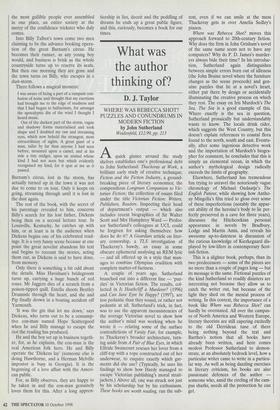What was the author thinking of?
D. J. Taylor
WHERE WAS REBECCA SHOT? PUZZLES AND CONUNDRUMS IN MODERN FICTION by John Sutherland Weidenfeld, £12.99, pp. 213 Aquick glance around the study shelves establishes one's professional debt to John Sutherland: Thackeray at Work, a brilliant early study of creative technique; Fiction and the Fiction Industry, a ground- breaking piece of literary economics; the compendious Longman Companion to Vic- torian Fiction; the collection of essays filed under the title Victorian Fiction: Writers, Publishers, Readers. Inspecting their head of department's output — which also includes recent biographies of Sir Walter Scott and Mrs Humphrey Ward — Profes- sor Sutherland's colleagues at UCL could be forgiven for asking themselves: how does he do it? A Guardian article on liter- ary censorship, a TLS investigation of Thackeray's bawdy, an essay in some obscure ephemeral analysing an REM lyric — and all offered up in a style that man- ages to combine Olympian erudition with complete matter-of-factness.
A couple of years ago, Sutherland branched out into a different line — 'puz- zles' in Victorian fiction. The results, col- lected in Is Heathchff a Murderer? (1996) and Can Jane Eyre be Happy? (1997), are less pedantic than they sound, or rather not pedantic at all. Sutherland's trick, in fact, was to use the apparent inconsistencies of the average Victorian novel to show how the author's mind was working when he wrote it — relating some of the surface contradictions of Vanity Fair, for example, to Thackeray's broader architecture, turn- ing aside from A Pair of Blue Eyes, in which Elfride Swancourt rescues her lover from a cliff-top with a rope constructed out of her underwear, to enquire exactly which gar- ments did she use? (Typically, he uses his findings to show how Hardy managed to escape Victorian publishing's moral strait- jackets.) Above all, one, was struck not just by his scholarship but by his enthusiasm. These books are worth reading, ran the sub- text, even if we can smile at the mess Thackeray gets in over Amelia Sedley's pianos.
Where was Rebecca Shot? moves this approach forward to 20th-century fiction. Why does the firm in John Grisham's novel of the same name seem not to have any computers? Why do P. D. James's murder- ers always bide their time? In his introduc- tion, Sutherland again distinguishes between simple errors born out of idleness (the John Braine novel where the furniture changes as the scene proceeds) and gen- uine puzzles that lie at a novel's heart, either put there by design or accidentally illuminating the creative process on which they rest. The essay on Iris Murdoch's The Sea, The Sea is a good example of this. Where exactly is the sea in question, Sutherland prosaically but understandably wants to know. The locals drink cider, which suggests the West Country, but this doesn't explain references to coastal flora found to the north, south and east. Eventu- ally, after some ingenious detective work and the importation of Murdoch's biogra- pher for comment, he concludes that this is simply an elemental ocean, in which the author's mythological design radically exceeds the limits of geography.
Elsewhere, Sutherland has tremendous fun trying to unravel the notoriously vague chronology of Michael Ondaatje's The English Patient, while showing how Antho- ny Mingella's film tried to gloss over some of these imperfections (notably the appar- ent ability of the heroine's body to lie per- fectly preserved in a cave for three years), discusses the Hitchcockian personal appearance in novels by Bradbury, Lodge and Martin Amis, and reveals his awesome up-to-dateness in discussion of the curious knowledge of Kierkegaard dis- played by low-lifers in contemporary Scot- tish fiction.
This is a slighter book, perhaps, than its two predecessors — some of the pieces are no more than a couple of pages long — but its message is the same. Fictional puzzles of the kind Sutherland so readily disinters are interesting not because they allow us to catch the writer out, but because of the light they shed on the mental process of writing. In this context, the importance of a book like Where was Rebecca Shot? can hardly be overstated. All over the campus- es of North America and Western Europe, literary theorists are still capering excitedly to the old Derridean tune of there being nothing beyond the text and Barthes's notion that all books have already been written, and here comes modest Professor Sutherland to demon- strate, at an absolutely bedrock level, how a particular writer came to write in a particu- lar way. As well as being dazzling exercises in literary criticism, his books are also passionate defences of the author — someone who, amid the circling of the cam- pus sharks, needs all the protection he can get.










































































 Previous page
Previous page